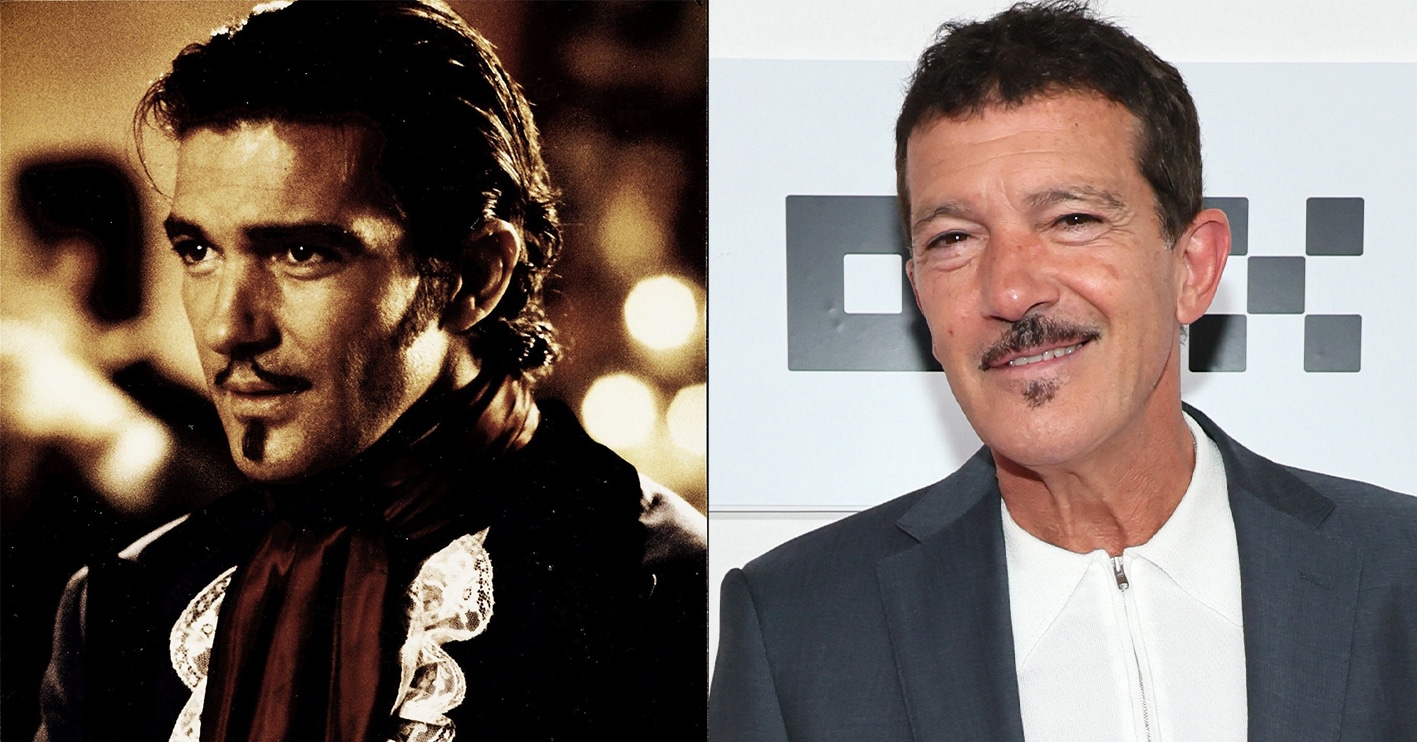The Mask of Zorro was released 21 years ago to critical acclaim and was a hit at the box office, too, bringing the classic story of Zorro to a whole new generation of fans and giving Antonio Banderas the role that he was probably born to play! The film was filled with fun, action, humour and romance and made us sit on the edge of our seats as the action unfolded on the big screen.
Let’s take a look at this classic with some facts about The Mask of Zorro you may not have known.
20. Sean Connery nearly played the elder Zorro
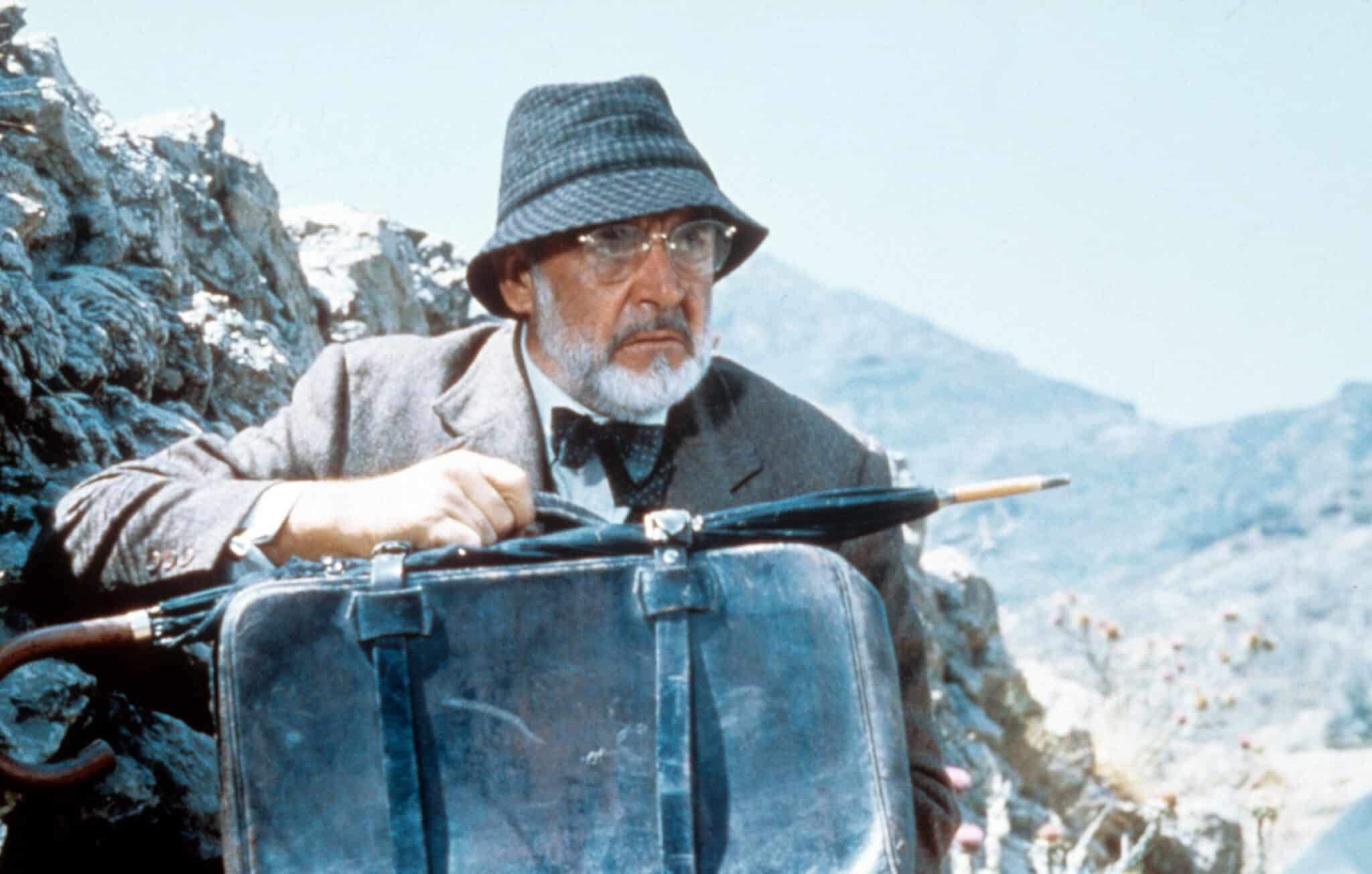
The production behind The Mask of Zorro was a troubled one. Initially, the film was set to be directed by the little-known Danish cinematographer Mikael Solomon at the recommendation of Steven Spielberg, and Solomon was intent on casting Sean Connery as Don Diego de la Vega. Solomon was keen that the rest of the cast besides Connery would be Latino, but after missing a planned April 1995 start for principal photography, Solomon dropped out, and Connery with him.
In a surprising twist, when offered the role of Don Diego de la Vega, Hopkins initially refused the role due to lower back pain. While de la Vega is the elder Zorro, Hopkins was approaching 60 at the time of filming, and largely considered his time for starring in action movies was over. Thankfully, Hopkins elected to have laser surgery on his back which relieved his pain, but it turns out that neither Connery nor Hopkins was the first choice for Zorro Senior… When the film was conceived, those attached at the time dreamed of casting Raul Julia, the iconic 80s and 90s star of The Addams Family (1991, 1993). Sadly, however, Julia died before he could play the role.
19. The film’s sword trainer called Banderas the most talented screen swordsman since Errol Flynn

Well before The Mask of Zorro, and far earlier than the kinds of roles he takes nowadays, Antonio Banderas had established his career as an actor with several relatively dark films, including Pedro Almodóvar’s Matador (1986) and Women On the Verge of a Nervous Breakdown (1988). As a result, despite Zorro being a classic swashbuckler, Banderas was keen to bring a sense of authenticity to the role. Banderas wanted the film to look as realistic as possible, and therefore insisted on performing the vast majority of the stunts himself, including all of the difficult fencing sequences.
To achieve a level of swordsmanship not only good enough to film, but good enough to feel authentic, Banderas spent time training with the Spanish Olympic team and also with legendary sword trainer Bob Anderson, who had worked with Errol Flynn and had choreographed fight sequences in Star Wars. As (eventual) director Martin Campbell remarked, “We used to call him Grumpy Bob on the set, he was such a perfectionist… He also refused to treat any of the actors as stars.” Apparently, however, Banderas’ commitment to the role paid off: Anderson reputedly said that he was the most talented swordsman he’d worked with since Errol Flynn.
18. The film could have been R-rated

For a film that’s fundamentally about waving big knives around and attempting to cut people open, The Mask of Zorro isn’t a very violent film. In fact, Banderas stays true to the gentleman swashbuckler archetype made famous by Errol Flynn and smiles throughout his sword fights – a far cry from the miserable Zack Snyder superhero flicks of today. But the film could have gone in a very different direction. Producers had considered putting Robert Rodriguez in the director’s chair, a figure known for more gruesome violence and as a friend of renowned gritty writer-director Quentin Tarantino.
Rodriguez had gained notoriety with the independent action film El Mariachi (1992), which was granted a sequel in 1995 – Desperado – starring Antonio Banderas and Salma Hayek. The films primarily concern violent acts of revenge against drug lords. While Rodriguez’s efforts were broadly praised, Desperado in particular was noted for being visually stunning but suffering from an “overdependence on violence.” When Rodriguez was tipped to direct The Mask of Zorro, therefore, it’s no surprise that he was planning to earn the film an R-rating with that same kind of violence, but this was met with disapproval from the studio and so the director was switched.
17. Steven Spielberg got Catherine Zeta-Jones cast as Elena

In the earliest days of the film’s production, Steven Spielberg was considering stepping up to direct. Ultimately, however, he declined, but remained attached as an executive producer. So when it came time to cast the film’s female lead and romantic interest, he was quick to make a suggestion which stuck. It’s easy to forget now, but before the Oscar-winning epic romance starring Leonardo DiCaprio and Kate Winslet in 1997, there was actually a Titanic mini-series that aired on CBS the previous year.
Directed by Robert Lieberman, the series follows a strangely similar trajectory to the imminent film, with Catherine Zeta-Jones playing a woman torn between following her heart or the wishes of her family, and a young vagrant stealing aboard the ship – though the two are unrelated in this production. While the series won an Emmy for ‘Outstanding Sound Mixing for a Drama Miniseries or a Special’, and was nominated for its costumes, the series was critically panned. In one silver lining, however, the series was watched by Spielberg, who enjoyed Catherine Zeta-Jones’ performance so much that he recommended her for the part of Elena in The Mask of Zorro.
16. Both the director and Hopkins turned down a James Bond movie to make Zorro

Insofar as it ever went away at all, the James Bond franchise was having something of a renaissance in the mid to late 90s as Irish hunk Pierce Brosnan took up the role of 007 in 1995’s Goldeneye, which was praised for “breath[ing] fresh creative and commercial life” into the series. Critics and fans alike waited on tenterhooks to see where the world’s most famous secret agent would go next, and it was widely believed that being part of the follow-up to Goldeneye was the hottest ticket in town. But at least two major Hollywood players didn’t see it that way. Martin Campbell had in fact directed Goldeneye, and was described by Brosnan as “warrior-like in his take on the piece.”
Given the critical and commercial success of the film – it grossed $355 million at the box office – Campbell was asked back for the next film, which would become Tomorrow Never Dies (1997). However, Campbell chose Zorro instead; according to his agent, Campbell didn’t want to do two Bond films in a row, though he would return to direct Casino Royale (2006). Anthony Hopkins, who had also been considered for a part in Goldeneye, was offered the role of Carver, but chose to work on The Mask of Zorro instead. Supposedly, Hopkins was annoyed that, when approached for the latest Bond, the script had not yet been completed.
15. Banderas went on to reprise his role several times… Kind of

Although Banderas is still taking on live-action roles, such as 2019’s Laundromat from Steven Soderbergh, nowadays he is best known as the voice behind Puss in Boots, a supporting and spin-off character from the Shrek franchise. Given the fencing feline’s obvious and intentional similarities to Banderas’ most famous portrayal, you could even consider Puss in Boots to be part of the overall Zorro canon.
Banderas’ first ‘appearance’ as the character was in Shrek 2 (2004), and a standalone movie – simply titled Puss in Boots – was released to critical and commercial acclaim in 2011. It grossed $555 million from an initial budget of $130 million. While a prequel was originally mooted for 2018, the film was quietly removed from schedules and focus was placed on a six-season Netflix TV series, with Eric Bauza taking over the main role. Despite originally being a European fairytale dating back to 1697 (‘Master Cat, or The Booted Cat’), much of the humour of the character is derived from sly nods to the romantic, swashbuckling swordsmanship that Banderas showed off in The Mask of Zorro. Oh, and coughing up hair.
14. There was a sequel in 2005
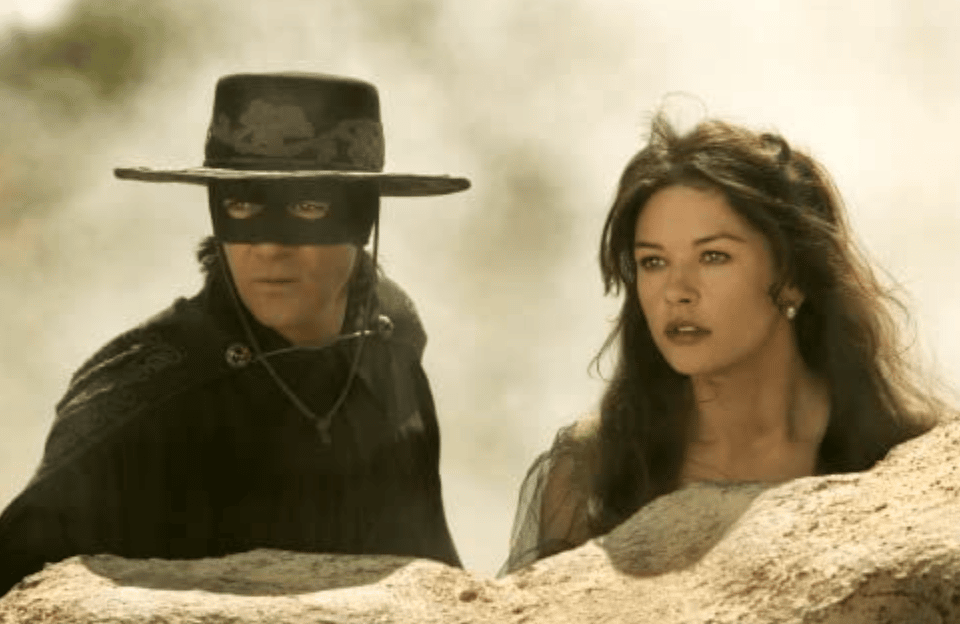
We don’t need to tell you that successful films get sequels. Even immensely poorly received films get sequels these days. But it’s rare that a sequel manages to get all of the original players back together, as much as seven years later, and that’s what The Legend of Zorro (2005) can boast. The film sees Banderas and Zeta-Jones reunite as Zorro and Elena – now husband and wife – and try to ensure California becomes a US state. The film was a lukewarm success at the box office, earning $142.4 million from an initial budget of $75 million, but given the aggressive promotional efforts for the film, the profit margin wasn’t quite as impressive as that statistic might have you believe.
Critics reacted incredibly negatively to the film, with Roger Ebert noting that “of all of the possible ideas about how to handle the Elena character, this movie has assembled the worst ones.” The film holds a score of 26% on Rotten Tomatoes. Given the spiky reception to The Legend of Zorro, there have been no announcements of any further instalments in the franchise, and Banderas would likely be considered too old to reprise the role once more – but hopefully, we haven’t seen the last of the debonair vigilante.
13. Zorro is based on a real-life figure

While it’s hard to imagine anyone but Banderas associated with the Zorro name, the character in fact appeared in much older media and is even based on a real-life historical figure. The character was created by American writer Johnston McCulley in 1919, and first gained prominence in the wake of a 1920 silent film – The Mark of Zorro – starring Douglas Fairbanks. However, the origins of Zorro’s character can be traced back even further, not only in the literary sense (to Baroness Orczy’s Scarlet Pimpernel from 1905) but to the real-life bandit Joaquin Murrieta.
Around the time of the 1849 Gold Rush, Murrieta and Three-fingered Jack were bandits active in Northern California, with Murrieta being a Mexican who had moved to California to seek his fortune. But after being beaten and robbed, he swore vengeance on the Americans who had dishonoured him. The story goes that Murrieta was killed by Captain Harry Love in July of 1853, who preserved his head in a jar as a trophy and as proof of his deed. Banderas’ character is called Alejandro Murrieta in reference to the real-life Joaquin. While the bandit himself is never mentioned, Alejandro and Elena name their son Joaquin in the sequel, further illustrating the films’ connection to historical fact.
12. There were multiple premieres just for Europe’s royals

If you were to screen a film for a prince or a king, perhaps you’d choose something erudite or something with a strong moral and political message. Basically, you probably wouldn’t pick The Mask of Zorro. However, in Spain, to celebrate the success of Antonio Banderas, a screening was held and attended by King Juan Carlos de Borbón and Princess Elena (coincidentally the name of Zeta-Jones’ character). This was the first Royal premiere seen in Madrid for seven years. In Britain, a Royal Command Performance for the film was attended by Prince Charles, Prince William, and Prince Harry.
Quite why British royalty would attend the premiere is unclear, though rumours have abounded in the past about an affair between Prince Charles and Catherine Zeta-Jones as early as 1992, while Charles was still married to Princess Diana. According to the dubious report, “[Charles] has watched The Mask Of Zorro many times. He says it’s one of his favourite films.” Without inventing rumours, perhaps they attended the premiere because The Mask of Zorro is an excellent film.
11. There was controversy over one of the film’s writers not being credited

The path to bring Zorro to the big screen was anything but sunshine and rainbows. Yet while most controversies erupt during tense encounters on set, The Mask of Zorro’s real disasters were in the script-writing process. The furore primarily concerned whether or not screenwriter David S Ward would receive a credit for his work on the film – he didn’t, despite the gargantuan effort he reportedly put in. “Looking back,” reads the article, “[Martin Campbell] believed that the credits should include David Ward, a veteran screenwriter who won an Oscar for best screenplay in 1973 for The Sting and has also directed films such as Major League and King Ralph.””
“‘I think he damn near rewrote every single line of dialogue in the script,’ Campbell said of Ward, who produced two different Zorro scripts and worked with the director during a physically demanding 98-day location shoot last year in Mexico.” Ultimately, a committee from the Writers Guild of America elected to share the credits between John Eskow (whose script was presented to the studio to persuade them to green-light the film) and the duo of Ted Elliott and Terry Rossio, who wrote the original screenplay.
10. The swords had to be dubbed in post-production

Movie props are fickle things: too heavy, and they’re unusable; too light, and the actors ease with them looks fake. So it’s interesting to learn that The Mask of Zorro was also beset with prop difficulties in the worst possible way: in its swords. The swords Banderas learned to fight with were made of aluminium, and as such produced a dull clunking noise whenever they collided. As a result, every single clang and clash of swords in the film had to be re-dubbed in post-production to make it sound as sharp and zippy as possible. Needless to say, in a film like The Mask of Zorro that’s a lot of dubbing.
However, the shiny aluminium swords did help in one respect. In the climactic scene, when Zorro confronts Captain Love, he draws his sword and the sun glints off the blade. This was in fact not CGI, but instead a suggestion by Antonio Banderas himself. The difficulty, however, was getting the sun to run the full length of the blade in one comprehensive shot, while also never breaking eye contact with the villain. As a testament to Banderas’ newfound skill with the blade, achieving the shot that can be seen in the film only took three attempts, and it remains one of the coolest moments of the film.
9. The studio launched a Zorro lawsuit against a 2000 TV series

Three years after The Mask of Zorro released in cinemas, Sony Pictures Entertainment filed a lawsuit against Fireworks Entertainment group. The lawsuit was brought against – in particular – the producers of the 2000 syndicated TV series Queen of Swords, that had launched the year before. The show concerns a Spanish aristocrat, Tessa Alvarado, who returns to her home in California to find it being degraded by a militaristic governor, who murders her father. Alvarado dons a mask and vows revenge. The similarities between Queen of Swords and The Mask of Zorro should be obvious.
Sony Pictures Entertainment’s lawsuit claimed that Queen of Swords infringed on copyrightable elements of the Zorro character, but the judge ultimately disagreed. When the ruling was made in April of 2001, the judge noted that the copyright on the original Johnson McCulley story and the Douglas Fairbanks adaptation in 1920 had long since lapsed, and as such Zorro has become a public domain character, and any other similarities did not warrant an injunction. Whether because of the financial onus of these legal troubles, or because of the poor reception of the show generally, Queen of Swords was cancelled after only eight episodes,
8. The training scene is based on a Jackie Chan film

The Mask of Zorro largely draws its influences from what you’d typically expect: the films of Errol Flynn, some Westerns and epic uprising films like Spartacus (1960). But in at least one particular case, Zorro pays homage to a film you wouldn’t normally guess. According to the DVD commentary by Martin Campbell, the scene in which Alejandro is doing push-ups – with de la Vega’s legs resting on him, and with candles burning below him, was inspired by a similar scene in “a Jackie Chan movie.”” The movie to which Campbell is referring is probably Snake in the Eagle’s Shadow (1978), a Hong Kong martial arts comedy.
The film predominantly focuses on the relationship between Chien Fu (Jackie Chan) and Pai Cheng-Tien (Yuen Siu Tien) who teaches the downtrodden Chien about the snake style of kung fu, with Chien eventually becoming a master of his own style. Snake in the Eagle’s Shadow was a success, and spawned a spin-off/sequel that aimed to capitalise on its popularity. It gained notoriety in the West as a classic martial arts film, which likely led to the homage in The Mask of Zorro.
7. The film was a box office triumph, but not exactly a critical darling

From the vantage point of the present, it’s hard to believe that The Mask of Zorro was anything less than destined to become a classic. But, at the time, things were altogether less certain. Even as the film opened to strong numbers, some critics were predicting its ultimate doom. Antonio Banderas’ first outing as the masked swordsman raked in $22,525,855 at the box office on its opening weekend in July 1998, debuting at number one. By the following weekend, however, the film had been displaced by Saving Private Ryan – the project for which Spielberg had left Zorro – and There’s Something About Mary. The Mask of Zorro would eventually gross $94,095,523 in the US, as part of a worldwide total of $250,288,523 from an initial budget of $95 million, with Roger Ebert calling it “probably the best Zorro movie ever made”.
However, not everyone agreed. Todd McCarthy of Variety described it as “somewhat overlong” and expressed concern that the film’s slower pacing would turn away younger viewers, despite the fact that the romantic portrayal of the lead, and a more capable female character in Elena, could entice more women to theatres. Ultimately, the film’s strong box office numbers proved the naysayers wrong, and it was even nominated for two Oscars in Sound and Sound Effects Editing. Unfortunately, the sequel would prove them absolutely right.
6. Producers changed the ending three months after filming had already ended

If you’ve ever thought that the ending of The Mask of Zorro – in which Alejandro and Elena are happily married with their infant son – is a little bit too sweet for your tastes, you’ve got Steven Spielberg to thank. Originally, the film concluded with Diego de la Vega dying in the arms of his daughter, and as a final act blessing the union between her and Alejandro. However, during post-production it was decided that this ending was too depressing, and insisted it be changed. Unfortunately, the decision was made nearly three months after principal photography had been completed.
The change in ending was likely an attempt to redress what some saw as an overly dark and serious tone for the film, which had been the feedback at initial test screenings, and there are few things more serious than Anthony Hopkins dying in your arms. The sequel, The Legend of Zorro, also has an alternate ending, with Joaquin (formerly the infant son of the first film) riding off into the sunset, implying that he will become the next Zorro. This was changed soon after it was filmed, however, to leave open the possibility that Banderas and Zeta-Jones would reprise their roles again – a possibility that the film’s box office numbers swiftly foreclosed on.
5. Its score was based on El Cid’s
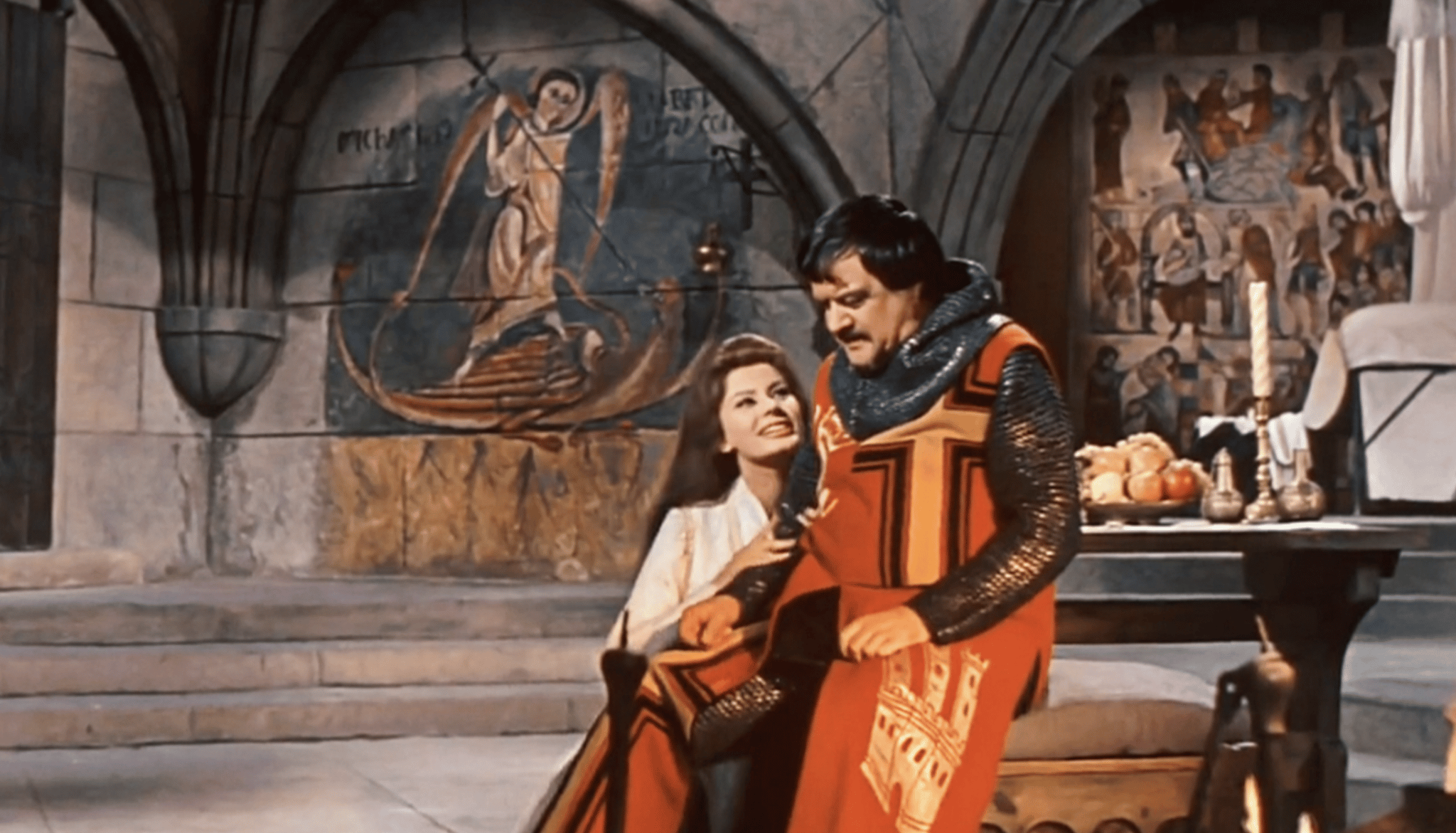
The music of The Mask of Zorro came in for particular praise on the film’s release, combining traditional flamenco music and the soaring orchestral thrills of Errol Flynn’s best films. Sadly, the composer for the film, James Horner, passed away in 2015, so it’s appropriate to pay particular attention to an underrated aspect of the film. Horner was keen to avoid what had become a stereotypical and Hollywood-sanitised version of Hispanic music, and noted that very few films managed to respect true Hispanic musical history. One of these that proved a great influence on Horner was El Cid (1961), directed by Anthony Mann and starring Charlton Heston.
The score for the film was composed by Miklós Rózsa, a veteran composer who scored nearly 100 films. Horner has said that he was keen, with The Mask of Zorro, to eliminate The Hollywood sound of the orchestra by bringing in the rhythm of dancing – literally the sound of feet against the ground – and insisted on his original score even as producers attempted to make it conform with other blockbusters. Horner himself was a prolific composer, who worked on Titanic (1997), A Beautiful Mind (2001), Avatar (2009), and many more. May he rest in peace.
4. Banderas had to alter lines to avoid English words he couldn’t say

Perhaps unfairly, we expect actors to be proficient in multiple languages, especially if those actors are to act in English language films. Antonio Banderas had actually worked at the height of cinema for almost ten years before being introduced to Hollywood – by Madonna, of all people – at which point he set to work finessing his command of English. Unfortunately for Banderas, he hasn’t yet worked out all of the kinks. Banderas’ first English language role was as Néstor Castillo, one of two brothers who have fled from Cuba to New York to revive their ailing music careers, in The Mambo Kings (1989). In spite of having to learn his lines phonetically, Banderas’ performance was praised.
He starred alongside Madonna in Evita (1996), and was well on the way to Hollywood super-stardom. But a lifetime is hardly long enough to fully master a second language, never mind just over five years. In particular, Banderas to this day struggles to say the word ‘animals’, admitting in an interview, “I just can never say it properly, whenever it is in a film I have to get it changed for a synonym. In Zorro, I had a line changed from ‘you look like a bunch of animals’ to ‘you look like a collection of beasts’. It worked much better, so I don’t care.”
3. People thought Catherine Zeta-Jones was really Spanish

Speaking of bilingualism, Catherine Zeta-Jones’ performance as Elena succeeded in tricking millions of audience members into thinking that she was in fact Spanish, a deliberate and fastidious effort by the Welsh actor to have an authentic accent. Not only did Zeta-Jones take Spanish lessons, but she also focused on horse riding, dancing – and, of course, fencing – during her preparation for what would become her breakthrough role, and perhaps her biggest to date. Zeta-Jones has commented that she believes her “volatile” Celtic temper helped her identify with her character, and survive the harsh filming schedule of dancing and corset-wearing in the Mexican desert.
It was a harsh experience, but one she ultimately thoroughly enjoyed. “After [filming] I had great expectations of continuing this and maybe being an Olympian sword woman, but course, lazy old me,” she noted in an interview to promote The Legend of Zorro. “When I first went down to Mexico City and I used to look at Antonio and Tony Hopkins getting followed around by autograph hunters,” Zeta-Jones has said. “And I used to be standing right next to them, not that I wanted, nobody knew me, but I used to go to the Museum of Archeology three times a week. People used to speak to me in Spanish. They thought I was Spanish. I used to get such great bargains at the markets.”
2. The secret behind slicing off the dress

It’s impossible to talk about The Mask of Zorro without talking about that scene. Sure, we remember Zorro fondly for the vague notions of its black-clad masked Spaniard, the idea of riding horses through the wilderness, and the clang of sword against sword, but these are all broad memories that you can’t really pin down. What we can pin down, however, is the scene in which Zorro and Elena duel, and then Zorro cuts off all her clothes. It’s probably the most popular and memorable scene from the entire film, for the simple reason that it combines both astonishing swordplay and a naked woman.
Of course, Banderas doesn’t actually cut Zeta-Jones’ dress off. Instead, the effect is achieved by some remarkable practical effects trickery. Wires were attached to the dress, and it was literally ripped off at the desired moment. Awkwardly – or understandably, depending on your perspective – both Banderas and Zeta-Jones have admitted that they were aroused by the scene. Let’s be honest: Zeta-Jones is a renowned beauty, so it’s not complicated that Banderas found her attractive; for Zeta-Jones, on the other hand, having your clothes torn off you is… an interesting stimulus.
1. The character inspired Batman
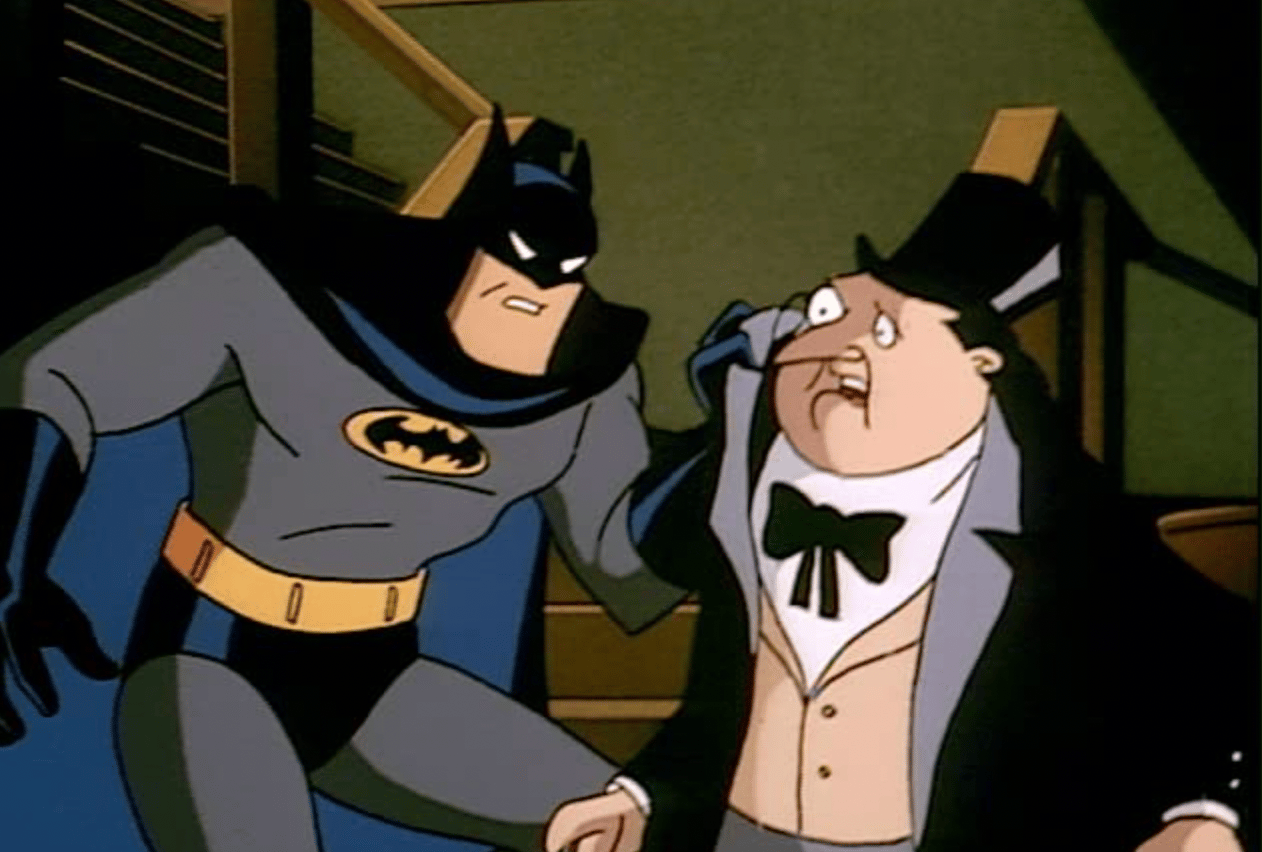
Clad in black, wearing a cape, and vowing to avenge the murder of their family – the similarities between Zorro and Batman are immediately obvious. But what’s more surprisingly true is that there’s a straight line between Zorro and the World’s Greatest Detective. It’s worth remembering that the character of Zorro was created in 1919, and Batman’s first comic book appearance was in 1939, a full two decades later. Batman creator Bob Kane has noted the influence that the Douglas Fairbanks Zorro film had over his character.
By highlighting some of the Zorro details you might have forgotten, the connections become even more obvious. Don Diego – played by Hopkins in the 1998 film – traditionally lives in a huge hacienda that has a complicated series of tunnels and passages below it, including one that leads to the hideout containing his horse, Tornado. In mid 19th century California, Tornado was probably the closest thing to the Batmobile. Diego also has a servant, Bernardo, who is deaf and mute, who provided inspiration for Alfred Pennyworth, Batman’s butler.

